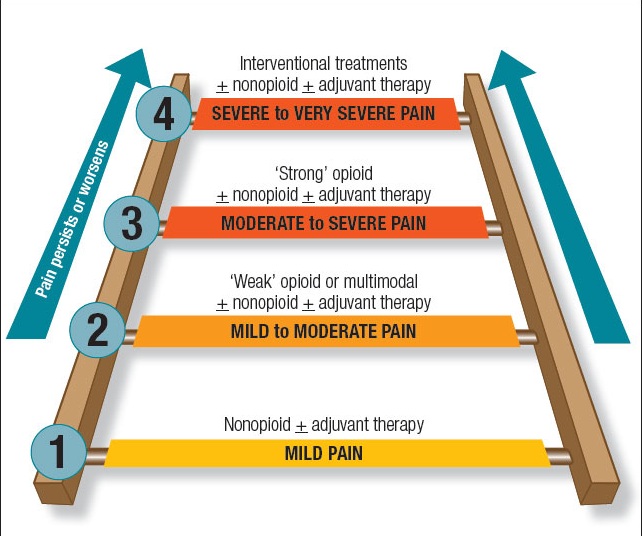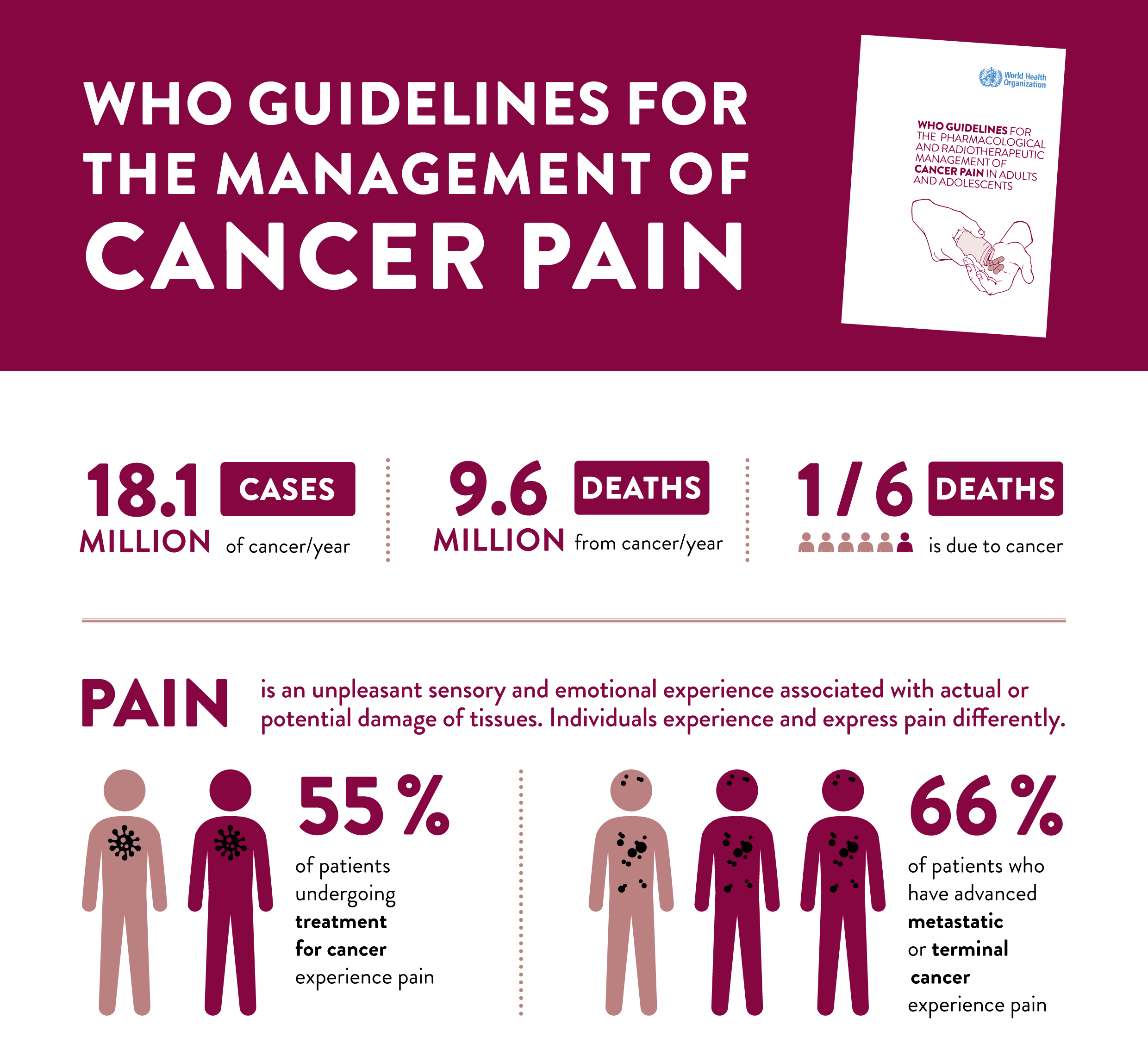Cancer Pain
Having cancer does not always mean having pain. But still approx 50 percent of all patients with cancer throughout the world die without relief from severe pain.In India too Cancer Pain is a major cause of suffering. The magnitude of problem is on the rise due to increase in life expectancy and newer diagnostic modalities. There are 1-1.5 million new cancer patients every year in India out of which 60-80% presents in advanced stage. Pain is a common symptom in cancer patients and the most feared complication. By 2020 It is estimated that there will be 2-2.5 million new cases in India every year and with the limited resources for diagnosing and treatment of cancer 80% of these patients will require pain management as the only treatment. Patients with different organs have different pain incidence: prostate (56-94%) head & neck (67-91%) uterine (30-90%) genitourinary (58-90%)breast (40-89%) and pancreatic (72-85%) cancer suffer from pain. If you do have pain, you can work with your health care team to make sure a pain relief plan is part of your care. There are many different kinds of medicines, different ways to take the medicines and interventional pain procedures that can help relieve it. How pain affects people with cancer? Any type of pain, not just cancer pain, can affect all parts of a person's life. Some days it may be better or worse than others. If you have pain, you might not be able to do your job well or take part in other day-to-day activities. You may have trouble sleeping and eating. You might be irritable with the people you love. It is easy to get frustrated, sad, and even angry when you are in pain. Family and friends do not always understand how you are feeling, and you may feel very alone. This is not unusual, so it is important to talk about your pain with your health care team so they can help. Can cancer pain be relieved? You should never accept pain as a normal part of having cancer. It is important to remember that all pain can be treated. Cancer pain may not always be completely relieved, but your doctor can work with you to control and lessen it as much as possible. Knowing how to report and describe it can help your pain specialist know how to treat it.

Contributory Factors
For those experiencing pain, the impact that it has on day to day living can be widespread; impacting all facets of life including employment, caring for children, relationships, sleep, mental and physical health and general activities of daily living (ADL). Holistic pain management is an approach that takes into account the emotional, mental, and spiritual needs of the individual in addition to the person's physical state.


Causes
The cancer itself often causes pain. The amount of pain you have depends on different factors, including the type of cancer, its stage (extent), other health problems you may have like diabetes, arthritis and your pain threshold (tolerance for pain). People with advanced cancer are more likely to have pain. Cancer surgery, treatments, or tests can also cause pain. You may also have pain that has nothing to do with the cancer or its treatment. Like anyone, you can get headaches, muscle strains, and other aches or pains. Pain from the cancer itself: Pain from the cancer can be caused by a tumor pressing on nerves, bones, or organs.Spinal cord compression: When a tumor spreads to the spine, it can press on the nerves of the spinal cord. This is called spinal cord compression. The first symptom of spinal cord compression is usually back and/or neck pain, and sometimes it is severe. Pain, numbness, or weakness may also happen in an arm or leg. Coughing, sneezing, or other movements often make the pain worse. If you have this kind of pain, it is considered an emergency and you should get help right away. Spinal cord compression must be treated right away to keep you from losing control of your bladder or bowel or being paralyzed. If you are treated for the compression soon after the pain begins, you can usually avoid serious outcomes. Treatment for spinal cord compression usually involves radiation therapy to the area where the tumor is pressing on the spine and steroids to reduce edema. Or you may be able to have surgery to remove a tumor that is pressing on the spine, which may then be followed by radiation. Bone pain: This type of pain can happen when cancer starts in or spreads to the bones. Treatment may be aimed at controlling the cancer, or it can focus on protecting the affected bones. External radiation may be used to treat the weakened bone.. Bisphosphonates are drugs that can help make weakened bones stronger and help keep the bones from breaking. These are examples of treatments that are aimed at stopping the cause of the bone pain. You may still need pain medicines, but sometimes these treatments themselves, can greatly reduce your pain. Bone pain can also happen as a side effect of medicines known as growth factor drugs or colony-stimulating factors (CSFs). These drugs may be given to help prevent white blood cell (WBC) counts from dropping after treatment. CSF drugs help the body produce more WBCs which are made in the bone marrow. Because the bone marrow activity is higher with these drugs, bone pain may occur. Pain from cancer surgery, treatments, and tests: Surgical pain: Surgery is often part of the treatment for cancers that grow as solid tumors. Depending on the kind of surgery you have, some amount of pain is usually expected and can last from a few days to weeks. Talk to your doctor about pain medicines you may need after surgery so you would not be in pain when your surgery is over. You may need stronger pain medicine at first after surgery, but after a few days or so you should be able to control it with less strong medicines. Phantom pain: Phantom pain is a longer-lasting effect of surgery, beyond the usual surgical pain. If you have had an arm, leg, or even a breast removed, you may still feel pain or other unusual or unpleasant feelings that seem to be coming from the absent (phantom) body part. Doctors are not sure why this happens, but phantom pain is real; it is not all in your head. No single pain relief method controls phantom pain in all patients all the time. Many methods have been used to treat this type of pain, including pain medicine, physical therapy, antidepressant medicines, and transcutaneous electric nerve stimulation (TENS), mirror therapy etc. If you are having phantom pain, ask your interventional pain specialist , what can be done. Side effects of chemotherapy and radiation treatments: Some treatment side effects cause pain. Pain can even make some people stop treatment if it is not managed. Talk to your cancer care team about any changes you notice or any pain you have. Here are some examples of pain caused by cancer treatment: 1. Peripheral neuropathy (PN). This refers to pain, burning, tingling, numbness, weakness, clumsiness, trouble walking, or unusual sensations in the hands, arms, legs, and/or feet. Peripheral neuropathy is due to nerve damage caused by certain types of chemotherapy, vitamin deficiencies, a tumor pressing on a nerve, or other health problems such as diabetes and infections. When caused by chemotherapy, it is sometimes called chemotherapy-induced peripheral neuropathy (CIPN). 2. Mouth sores (stomatitis or mucositis). Chemotherapy can cause sores and pain in the mouth and throat. The pain can cause people to have trouble eating, drinking, and even talking. 3. Radiation mucositis and other radiation injuries. Pain from external radiation depends on the part of the body that is treated. Radiation can cause skin burns, mucositis (mouth sores), and scarring-all of which can cause pain. The throat, intestine, and bladder are also prone to radiation injury, and you may have pain if these areas are treated.
Investigation
Most of the times no special investigations are needed to diagnose the cause of cancer pain. Most patients already have their blood investigations like CBC, LFT, KFT ,PET Scans etc done from their treating oncologists or onchosurgeon, and these investigations are sufficient. Some patients may present with pains unrelated to their cancer like prolapsed lumbar disc or knee osteoarthritis or tension type headache etc for which some specific investigations like X ray , MRi etc may be needed.
Treatment
Oral drug therapy: Oral analgesics are the mainstay of therapy for pain. An estimated 70-90% of patients can be rendered relatively free of pain, when rational principles of pharmacological management are applied in a thorough & careful manner. Zech et al. reported good pain relief in 76% of 2118 cancer patients treated in accordance with WHO guidelines over a 10 years period. Interventions in Cancer Pain: Consideration for neurolytic intervention in patients with cancer-related pain is indicated, when symptoms cannot be controlled adequately with medications & other conservative therapy, & when life expectancy is limited. Restrictions related to life expectancy are not rigid. Upper limits of 6 to 18 months have been recommended, but each case should be considered on its individual merit. Regardless, referring physicians should be encouraged to seek consultation early in the terminal disease since many techniques require patient cooperation to produce optimal results. Also, some indicate a higher incidence of failure of nerve blocks when pain has persisted in excess of 3 to 4 months (2).Psychological maladaptation & isolation of targeted neural tissue by radiation fibrosis or malignant cells are relative contraindications. Others contraindications include a history of trauma, infection, or congenital anomalies. The presence of active infection at the block site or anticoagulant therapy are absolute contraindications to nerve block. Neurolytic blocks should always be preceded by a temporary diagnostic block using local anaesthetics. Additionally, in many cases, various degrees of relief can be obtained from repeated blocks with local anaesthetics alone. Some cancer pain syndromes are more amenable to nerve blocks than others. Examples include a celiac plexus block to treat the pain of tumors of the liver, stomach, & pancreas, or paravertebral somatic blocks for patients with post-thoracotomy pain. Often the best results occur with patients who are blocked at an early stage of their illness. Various nerve blocks for cranial nerves, somatic & sympathetic nerves may be tried for lasting relief. Currently various invasive continuous infusion techniques using pumps & ports have been used. Radio frequency denervation & dorsal column stimulation (DCS) have also been successfully used in selected cases. Psychiatric & psychological methods are used as good complimentary tools in relieving pain. The situation may also be improved by suggesting modifications to the patient's way of life by using various rehabilitative methods.
Types of Pain
- Neck Pain
- Low Back Pain
- Thoracic Spine Pain
- Headache
- Shoulder Pain
- Elbow Pain
- Wrist Pain
- Knee Pain
- Peripheral Vascular Disease
- Neuropathic Pain Syndromes
- Fibromyalgia And Other Myofacial Pain Syndromes
- Chronic Regional Pain Syndrome
- Facial Pain
- Foot Pain
- Abdominal Wall Pain Syndrome
- Sacroiliac Joint Pain
- Cancer Pain
- Urogenital Pain Syndrome
- Chronic Pelvic Pain